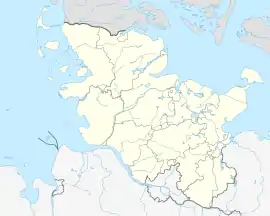Itzehoe
Itzehoe (German: [ɪtsəˈhoː] (![]() listen); Low German: Itzhoe) is a town in the German state of Schleswig-Holstein.
listen); Low German: Itzhoe) is a town in the German state of Schleswig-Holstein.
Itzehoe | |
|---|---|
 | |
 Coat of arms | |
Location of Itzehoe within Steinburg district  | |
 Itzehoe  Itzehoe | |
| Coordinates: 53°55′30″N 9°30′59″E | |
| Country | Germany |
| State | Schleswig-Holstein |
| District | Steinburg |
| Government | |
| • Mayor | Andreas Koeppen |
| Area | |
| • Total | 28.03 km2 (10.82 sq mi) |
| Elevation | 22 m (72 ft) |
| Population (2019-12-31)[1] | |
| • Total | 31,803 |
| • Density | 1,100/km2 (2,900/sq mi) |
| Time zone | UTC+01:00 (CET) |
| • Summer (DST) | UTC+02:00 (CEST) |
| Postal codes | 25501−25524 |
| Dialling codes | 04821 |
| Vehicle registration | IZ |
| Website | www.itzehoe.de |
As the capital of the district Steinburg, Itzehoe is located on the Stör, a navigable tributary of the Elbe, 51 km (31.7 mi) northwest of Hamburg and 24 km (14.9 mi) north of Glückstadt. The population is about 32,530.
The church St. Laurentii and the building in which the Holstein estates formerly met, are noteworthy. The town has a convent founded in 1256, many schools, a hospital and other benevolent institutions. Itzehoe is a busy commercial place.
Itzehoe is the oldest town in Holstein. Its nucleus was a castle, built in 809 by Egbert, one of Charlemagne's counts, against the Danes. The community which sprang up around it was variously called Esseveldoburg, Eselsfleth and Ezeho. In 1201 the town was destroyed, but it was restored in 1224. The new town was granted the Lübeck rights by Adolphus IV in 1238, and the old town in 1303. During the Thirty Years' War Itzehoe was twice destroyed by the Swedes, in 1644 and 1657, but was rebuilt on each occasion. It passed to Prussia in 1867, with the duchy of Schleswig-Holstein.
Itzehoe is listed as a garrison depot (Wehrkreis X, Hamburg) of the former Infanteriedivision 225. which was implicated in the 1940 Vinkt Massacre in Belgium.
Itzehoe is also the location of the Wenzel Hablik Museum.
During the period up to and including the Wacken Open Air festival, many festival goers chose to depart for the festival from Itzehoe using the 'Metal Shuttle Bus' which departs from near Itzehoe station. During this time, the town can become very overcrowded and inundated with traffic.
Germany's lowest elevation is to be found a short distance from Itzehoe, in the Wilstermarsch, which reaches 3.54 m below sea level. The town is twinned with Cirencester in the United Kingdom.[2]
Transportation
Itzehoe is situated at the Marsh Railway and offers connections to Hamburg and the island Sylt.
People
- Bruno Adler (1896-1954), Bishop of the German Christians
- Hans-Joachim Newiger (1925–2011), philologist
- H. G. Francis (1936-2011), writer
- Sabine Sinjen (1942-1995), actress
- Jerzy Janeczek (born 1944), actor
- Antje Blumenthal (born 1947), politician
- Sylvia Convey (born 1948), artist
- Olaf Berner (born 1949), teacher and handball player
- Heiger Ostertag (born 1953), historian
- Thomas Gerull (born 1962), winner of the Olympic silver medal in fencing
- Sven Butenschön (born 1976), ice hockey player
- Lisa Tomaschewsky (born 1988), actress
- Karl Armbrust (born 1867–1928), artist
References
- "Statistikamt Nord – Bevölkerung der Gemeinden in Schleswig-Holstein 4. Quartal 2019 (XLS-file)". Statistisches Amt für Hamburg und Schleswig-Holstein (in German).
- Cirencester Town Council - Twinning with Itzehoe Archived 2012-07-16 at the Wayback Machine
 This article incorporates text from a publication now in the public domain: Chisholm, Hugh, ed. (1911). "Itzehoe". Encyclopædia Britannica. 15 (11th ed.). Cambridge University Press. p. 87.
This article incorporates text from a publication now in the public domain: Chisholm, Hugh, ed. (1911). "Itzehoe". Encyclopædia Britannica. 15 (11th ed.). Cambridge University Press. p. 87.
| Wikivoyage has a travel guide for Itzehoe. |
External links
- Itzehoe Notgeld (emergency banknotes) depicting the inflation of staple prices in Germany between 1913–1921